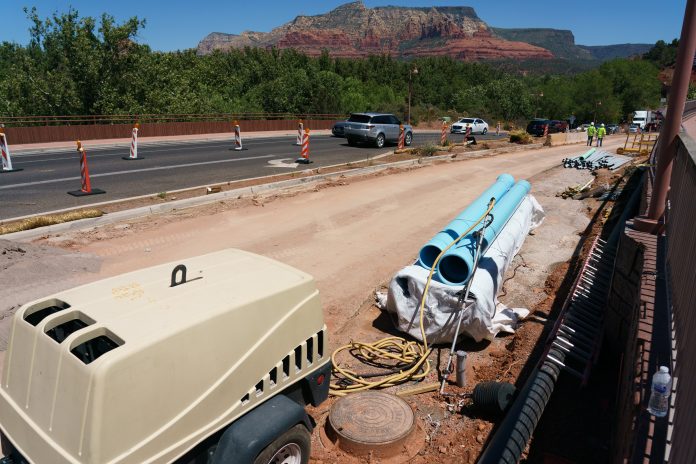
Even though the majority of test results are coming back below legal standards for E. coli bacteria following last week’s sewage spill into Oak Creek, the city of Sedona is taking steps to ensure it doesn’t happen again. But if it does, it wants to be better prepared.
The city reported that water quality counts taken between 8:49 and 11:15 the morning of Sunday, Aug. 9, show E. coli levels at all test sites but Red Rock Crossing remain below the state and federal water quality E. coli limit of 235 Colony Forming Units per 100mL of water for recreational swimming.
Red Rock Crossing came in at 307.6 CFU/100mL.
Sometime between 5 p.m. and 7:30 p.m. the night of Aug. 4, the State Route 179 Sewer Main Replacement Project suffered a sewage spill of 15,000 to 20,000 gallons of “untreated liquid effluent” along State Route 179 near the Hillside Sedona shopping center.
The project is currently under construction from the Schnebly Hill Road roundabout to Hillside Sedona.
Residents and passersby reported the effluent coming out of a manhole in front of the Hillside Sedona shopping center and flowing into a storm drain which then drained into Oak Creek approximately 750 feet downstream from the State Route 179 bridge over Oak Creek.
The spill was contained and disinfected around 8:30 p.m. that same evening. Kinney Construc-tion Services, the contractor for the construction project, is responsible for the accidental spill, according to a press release from the city.
The volume of effluent translates to approximately 150 gallons per minute, the city stated, adding that for comparison, Oak Creek’s rate of flow is 13,000 gallons per minute.
“The city is investigating the variability of E. coli results, including those from Aug. 9, 2020 at Red Rock Crossing,” a city press release states. “While the city sent the results to [Arizona Department of Environmental Quality] and informed Red Rock Crossing staff, it is not clear if these elevated numbers are the result of increased recreational activity on weekends, standard variation in samples or if there is any relationship to last week’s spill. The city will continue testing and working with ADEQ and area stakeholders to better understand these trends.”
The immediately-affected areas of the creek were cordoned off with yellow caution tape after the spill.
Kinney Construction Services, as well as city crews, hand-delivered information on this spill to some residents and businesses with direct creek access located downstream from the spill.
Other public notices were placed at trail heads and areas where people frequently access Oak Creek.
A sticking point for some was the fact that nearly 24 hours passed between the estimated time of the incident to when the city issued a press release on the spill.
City Manager Justin Clifton and Wastewater Director Roxanne Holland said the city’s protocol is to contact the ADEQ within 24 hours any time there is a wastewater-related spill of more than 50 gallons. Since ADEQ regulates and permits the wastewater plant, the city generally defers to that agency.
“This is especially true when something occurs that we’re not used to dealing with,” Clifton said.
Holland notified ADEQ first thing the next morning and also notified the National Response Center. Since this spill entered Oak Creek, she said ADEQ suggested later that morning they consult with their Surface Water Inspections and Compliance Unit, which is what the city worked with to get the message out.
Clifton said it was important to get clear input from ADEQ before distributing information to the public.
“We thought they could help articulate the level of concern and give clear guidance to us and area residents,” he said. “I’m not sure exactly when we finally heard from the right person and got clear on exactly what message to put out. But once we got that, we quickly put together a final press release, coordinated with Kinney Construction, and issued the release.”
In terms of the cause, Holland said during the construction work day, Kinney operates and maintains a bypass pumping system to convey sewer flows through temporary piping while workers replace sections of sewer line. At the end of the work day, workers revert back to the sewer main as primary conveyance. The bypass pumping system is left in place, and is used as a system to supplement sewer conveyance in the case of a back up in the main line.
“On Aug. 4 KCS was performing pressure testing of the new sewer main installation, which requires plugging the line to conduct the test,” Holland said. “The plug was inadvertently left in the sewer main and sewer conveyance was switched to the main line. This in turn caused a back up in the main line. In what I would characterize as a perfect storm, the bypass pumps also malfunctioned and failed to turn on as the main line was backing up. It appears to be a case where the float that triggers the pumps to turn on was damaged and caused the malfunction of the pumps.”
Being that the sewer line has no meter, unlike a water line, it’s not exactly known how many gallons flowed into the creek, Clifton said. These figures were based on estimates of flow and the duration in which the leak occurred.
“The fact that it went into the creek definitely elevated my level of concern,” Clifton said. “While spills do occur, you certainly don’t want raw sewage anywhere. The creek is a valuable asset to the area. It’s addressed in our Vision Statement and Community Plan and is cherished.”
Residents report at least two other such spills in July near the same location. One resident said he rode his bike through the wastewater before realizing what it was and calling the city.
The first spill was June 28, according to Holland. Pumps were set to the off position instead of the auto position after normal hourly checks on the pumps. The spill was about 15 minutes in duration before the pumps were turned back on and was approximately 1,000 gallons.
The spill was confined to roadway surfaces and a storm drain, but no water exited the stormdrain outfall, Holland wrote. Cleanup of that spill included disinfection of the roadway and the storm drain.
The second spill was on July 7, Holland wrote, and occurred because of a mechanical failure of the bypass pumps. The pumps were down for approximately 30 minutes and the spill was approximately 2,000 gallons.
The spill entered the storm drain and exited into an unnamed stormwater discharge wash, Holland wrote. Sandbags were placed in the wash to contain the spill and the roadway, storm drain, and wash were all disinfected. Soil samples were tested for fecal coliform in the wash and results indicated residual bacteria in the soil, so further disinfection and testing is occurring until the results match background levels for fecal coliform for a control sample in close proximity but outside of the spill area.
As a result of these two spills, the contractor was required to switch to back to the sewer main at the end of the day, so that the bypass pumps would not be the primary method for conveyance after hours. In addition, Kinney increased watch over the pumps during working hours from hourly to having a watch person at all times.
In terms of how the situation was handled, Clifton added, “We realize there’s room for a lot of improvement.”
In order to best address this incident and any future ones, city staff said they are forming a stakeholders group and the plan is to have it in place within the next two months, the city stated. The group is slated to include city staff, environmental agencies such as Oak Creek Watershed Council, health officials from Coconino and Yavapai counties, residents, business owners and possibly ADEQ.
Clifton anticipates the group will meet two or three times to review this incident, recommend changes, draft protocols and review the findings. These will include construction oversight and accountability as well as identifying clear protocols for public notice.
While daily testing is expected to stop this week and weekly testing to commence, the contractor has agreed to bring in a third-party inspector to make sure that once work ends each day, items are checked off a list to ensure this oversight does not occur again during the duration of this project.
The sewer project is supposed to conclude “midsummer,” with the original end date of July 13.
“We want to be open and transparent when something like this occurs,” Clifton said. “We can’t go back in time — I truly wish this hadn’t happened — but we will learn from this and move forward in a better way.”





















